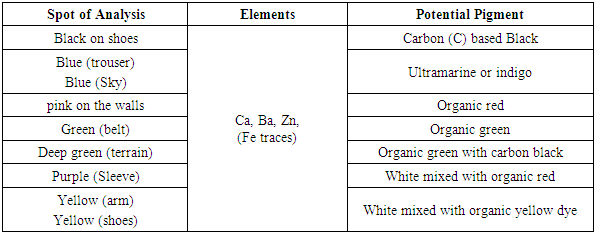-
Paper Information
- Paper Submission
-
Journal Information
- About This Journal
- Editorial Board
- Current Issue
- Archive
- Author Guidelines
- Contact Us
International Journal of Arts
p-ISSN: 2168-4995 e-ISSN: 2168-5002
2020; 10(2): 27-32
doi:10.5923/j.arts.20201002.01

Research Study in Two Unpublished Artworks of the Important Greek Artist, Theofilos Hadjimichael (1870-1934)
Stella Mouzakiotou1, Nikolaos Laskaris2, Theodore Ganetsos2
1Hellenic Open University & University of West Attica, Athens, Greece
2Department of Industrial Design and Production Engineering, University of West Attica, Athens, Greece
Correspondence to: Stella Mouzakiotou, Hellenic Open University & University of West Attica, Athens, Greece.
| Email: |  |
Copyright © 2020 The Author(s). Published by Scientific & Academic Publishing.
This work is licensed under the Creative Commons Attribution International License (CC BY).
http://creativecommons.org/licenses/by/4.0/

The purpose of this research is to highlight, study and publish two very important signed works of the Greek folk painter - hagiographer of modern Greek art, Theofilos Hatzimichael (1870-1934), which belong to a private collection. These are the works: 1. New type of rural Mytilene with its coexistence that weaves in rocket, wood painting, time: 1931. 2. The young Hercules Panais Koutalianos in England, wood painting, time: 1932. The dominant element in Theofilos' work is Greekness and the illustration of the Greek folk tradition and history. He spent most of his life in Pelion, while in 1927 he returned to Mytilene. In Mytilene, despite the mockery and teasing of the people, he continues to paint, making several murals in villages, for a fee, usually for a plate of food and a little wine. Many of the works of this period have been lost, either due to physical damage or destruction by their owners. In Mytilene, he was met by the renowned art critic and publisher Stratis Eleftheriadis (Tériade), who lived in Paris. Eleftheriadis owes much to the recognition of the value of Theophilos' work and its international promotion, which, however, took place after his death. Through the present study of the aforementioned works, we will highlight unknown aspects of the last phase of Theophilos' artistic creation, a period particularly important for the thorough and kaleidoscopic knowledge of his work, since it is the period that is visible through his color palette and His stylistic choices are the optimism and security conveyed to him by the acquaintance and support he receives from Eleftheriadis. Finally, the present work for the study of Theophilos' two unpublished works will be scientifically strengthened by utilizing the achievements of technology. Specifically, in the context of current study, the portable non-destructive techniques of the Non-Destructive Techniques Laboratory of the University of West Attica will be used. In particular, the techniques will be used: 1) portable Raman spectroscopy, for the authenticity test of the paintings 2) portable XRF spectroscopy, for the qualitative analysis of the data concerning the colour palette of the creator, compared to other identified paintings by NTUA.
Keywords: Theofilos Hatzimichael, Colour pallet, XRF spectroscopy, Raman Spectroscopy
Cite this paper: Stella Mouzakiotou, Nikolaos Laskaris, Theodore Ganetsos, Research Study in Two Unpublished Artworks of the Important Greek Artist, Theofilos Hadjimichael (1870-1934), International Journal of Arts, Vol. 10 No. 2, 2020, pp. 27-32. doi: 10.5923/j.arts.20201002.01.
Article Outline
1. Introduction
- The purpose of current work is to highlight, study and publish two very important signed works of the Greek folk painter - hagiographer of modern Greek art, Theofilos Hatzimichael (1870-1934), which belong to a private collection. These are the works: 1. "New type of rural Mytilene with its coexistence that weaves in rocket", wood painting, time: 1931. 2. "The young Hercules Panais Koutalianos in England", wood painting, time: 1932. The dominant element in Theofilos' work is Greekness and the illustration of the Greek folk tradition and history. Born between 1867 and 1870 in Varia, Lesvos, his father, Gabriel Kefalas (or Kefalas), was a shoemaker and his mother, Penelope Hadjimichael, was the daughter of a hagiographer. At a young age he showed moderate school performance, but also a special interest in painting, on which he acquired basic knowledge next to his grandfather. His life was very difficult because of the people who mocked him, because he was circulating wearing the traditional fustanela. At the age of about eighteen, he left his family environment and worked as a gatekeeper ("Kavasis") at the Greek Consulate in Smyrna. He stayed there for a few years, before settling in the city of Volos, around 1897, looking for occasional jobs and painting houses and shops in the area, so that today the frescoes he made there survive. He spent most of his life in Pelion, while in 1927 he returned to Mytilene. It is alleged that the reason for his departure from Volos was an incident in a cafe, when some children, in order to have fun, threw Theophilos from a staircase where he was up and painting.In Mytilene, despite the mockery and teasing of the people, he continues to paint, making several murals in villages, for a fee, usually for a plate of food and a little wine. Many of the works of this period have been lost, either due to physical damage or destruction by their owners. In Mytilene, he was met by the renowned art critic and publisher Stratis Eleftheriadis (Tériade), who lived in Paris. Eleftheriadis owes much to the recognition of the value of Theophilos' work and its international promotion, which, however, took place after his death. The conceptual clarification of this work is carried out through the complex process in which all the parameters (theoretical, stylistic study and technological support of new non-destructive means) are involved that will reveal new aspects in the field of visual research and study of these unpublished works. The research covers on the one hand a broader historical (Asia Minor Catastrophe, etc.) and a socio-economic context that defined Theophilos' artistic creation, and on the other hand it unfolds the artistic context that interprets and clarifies the specific artistic choices and influences accepted by the author.In the promotion, stylistic study and analysis of the two unpublished works of the important Greek folk painter, Theofilou - works of global interest that contribute to the kaleidoscopic approach to the art of this period, since the works are unknown, research, to date - in the scientific community according to Panofsky, the three-way process: 1. Listing the project's identity and description (converting the image into speech, without analysis). 2. Iconographic analysis. 3. Stylistic analysis and interpretation. The research conclusions that are emerge through the research study of the aforementioned works shed light on unknown aspects of the last phase of Theophilos' artistic creation, a period particularly important for the thorough and kaleidoscopic knowledge of his work, as it is the period that emerges his color palette and his stylistic choices, the optimism and security that the acquaintance and the support he receives from Strati Eleftheriadis (Tériade) convey to him. The innovative nature of this work initially lies in highlighting the cohesive elements of Theophilos' art with popular culture, filtered by the socio-political data of his time on the one hand, but also its comparative and interactive relationship with Naïve art in Europe by the other. This research approach is necessary, as the material to date is particularly poor, with no reliance on sources of information derived from the comparative study of specific works of art by representatives of art in Europe [1]. • In addition, the collaboration in the field of art history with the use of new technologies, is a practice that is not widely used for documentation purposes in Greece and for conclusions concerning works by specific artists (as opposed to individual cases that focus purely on issues maintenance).In particular, the techniques will be used:1) portable Raman spectroscopy, for the test - authenticity of the table.2) portable XRF spectroscopy, for the qualitative and quantitative analysis of the data concerning the colour palette of the creator and comparative presentation of the paints of the painter's palette in relation to other well-known identified works by the NTUA.• Also, the above collaboration of the two scientific fields (theoretical study and applied scientific knowledge), at this level, can function as a "platform" for creating a network of similar actions in other galleries or collections, as most Greek galleries and collections have in their possession works by the important painter Theofilos, whose value is bibliographically proven. Thus, the future interaction of the art spaces that host his works is a constant goal.
2. Materials and Methods
- Materials The first artwork (figure 1) has title “New type of rural Mytilene with its coexistence that weaves in rocket” and it is signed as “artwork of Theofilos G.X. Michael 1931” (in Greek: “Νέος τύπος χωρικού Μυτιληνιού με την συμβιαν του στην ρόκα - Έργον Θεόφιλου Γ.Χ. Μιχαήλ 1931”).
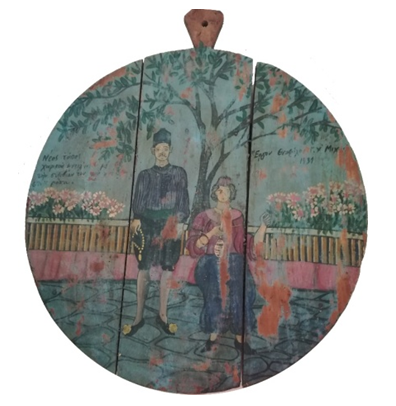 | Figure 1. New type of rural Mytilene with its coexistence that weaves in rocket, artwork of Theofilos G.X. Michael 1931 |
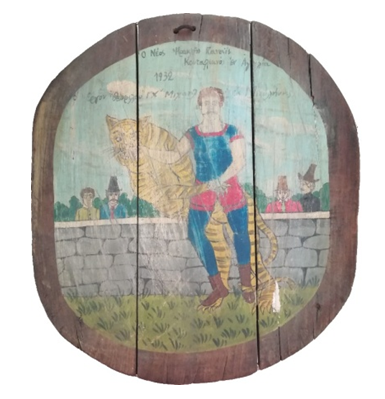 | Figure 2. The young Hercules Panais Koutalianos in England, 1932 artwork of Theofilos G.X. Michael from Mytilene |
3. Review of Previous Works
- Historical EvidencesThe only work citing the pigments of Theofilos, is that of G. Tsimploulis in 2010 [4]. The author reports that a) “Theophilos made the colour by himself from natural materials, but he never revealed exactly how he made themb) “For the colours he was pounding grass, flowers and pomegranate peels and then mixing them with common dyes.c) “He used to put fig milk or egg white in the paints to as colour stabilizer. The colors that Theofilos worked on were cheap powders and he used linseed oil, glues, milk for binders.”Analytical ResultsUntil this publication, the only previous published works about Theofilos colour pallet are those of Saint et al (2018) and Saint et al (2019) [5,6]. In these works, authors mention that after a detailed investigation of several artworks of Theofilos their research findings are:a) In all XRF analysis the elements Zinc (Zn), Barium (Ba), Calcium (Ca) and Lead (Pb) are present. This leads to the hypothesis of the use of Lithopone (mixture of ZnS and BaSO4) and/or Zinc White (ZnO) and/or Barium White (BaSO4) and/or Lead White (2PbCO3∙Pb(OH)2) and of Calcite (CaCO3) or Gypsum (CaSO4∙2H2O) as white for colour mixture or preparation layer of canvas. b) From the XRF analysis of blue colour hues, Cu was missing which leads to the hypothesis of use of Cu-free pigment (organic or inorganic) such as Ultramarine ((Na,Ca)8(AlSiO4)6(SO4,S,Cl)2) or indigo (C6H10N2O2) or even Prussian Blue (Fe4(Fe(CN)6)3∙nH2O). As Indigo was quite expensive colorant is relatively unlikely to be used by Theofilos while the very low percentages of Iron (Fe) do not guarantee the use of Prussian Blue. c) For the green color hues, the yellow ocher (Iron Oxide, Fe-O) is probably used in a mix with ultramarine blue color, while the XRF spectra have a high content of Ba, Ca, Zn, Fe, Pb. Also possible is the mixture of ultramarine with green earth with the form of celadonite [K [(Al, Fe3 +), (Fe2 +, Mg) (AlSi3, Si4) O10 (OH) 2] and glauconite [K, Na) Fe3 +, Al, Mg) 2 (Si, Al) 4O10 (OH) 2] for the production of the blue-green and green color impressions. d) For the yellow and brown color hues, the painter used earthy pigments rich in Hematite (Fe2O3) and/or Goethite (FeOOH), such as caput mortuum or some ochre or a combination of these.e) For the dark red and red-violet shades, earthy pigments were used with Hematite as the main ingredient, as evidenced by the high Fe content. In contrast, bright red as well as pink shades come from the use of minion (Pb3O4) diluted with white pigments.
4. Results and Discussion
- XRF analysesIn figure 3 and 4 the results of XRF analysis for both artworks are presented, while in ta bles 1 and 2 the summarized elements found.
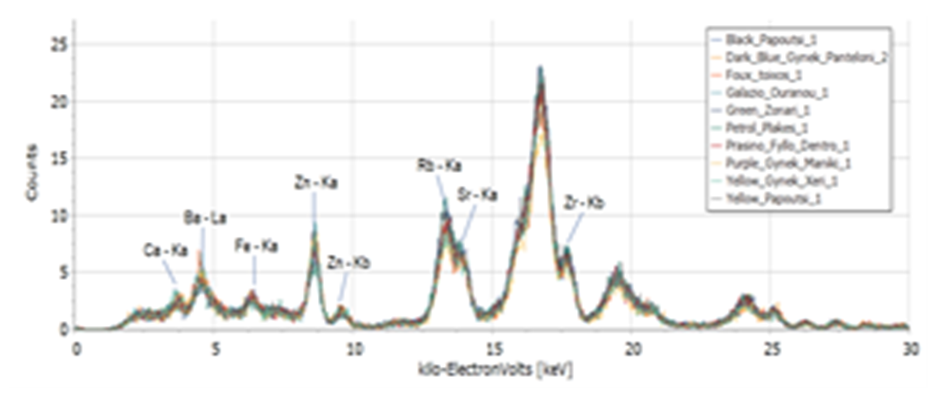 | Figure 3. XRF results for the 1st work of Theofilos (see figure 1) |
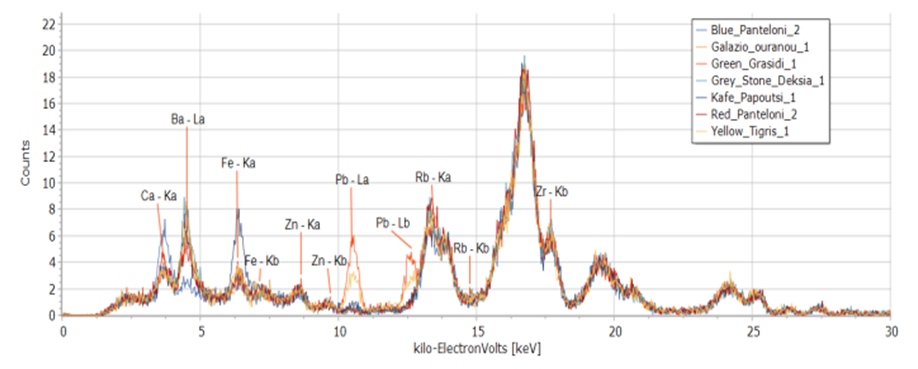 | Figure 4. XRF results for the 2nd work of Theofilos (see figure 2) |
|
|
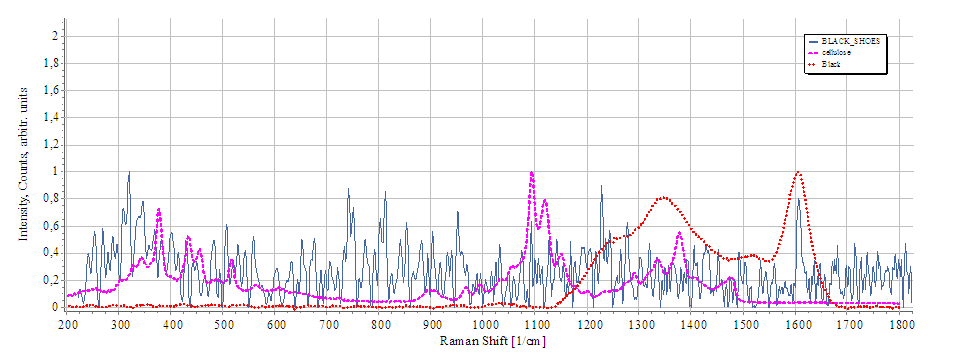 | Figure 5. Raman spectra for black of table 1 (blue line) and reference spectrum of carbon black (red dashed line) and cellulose (magenta dotted line) |
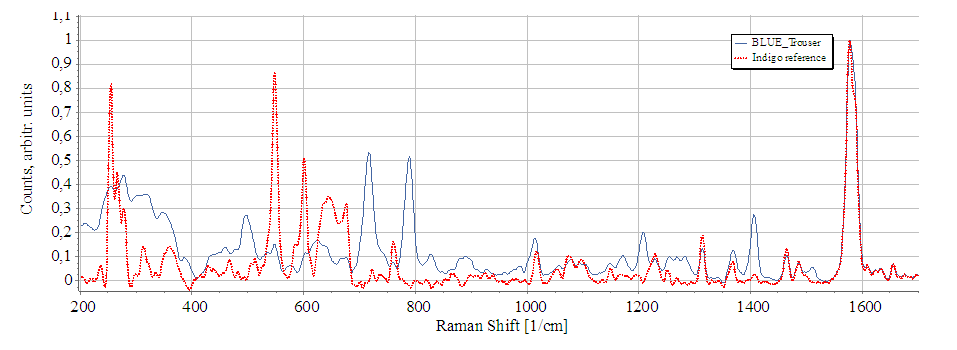 | Figure 6. Raman spectra for blue of table 2 (blue line) and reference spectrum of Indigo (red line) |
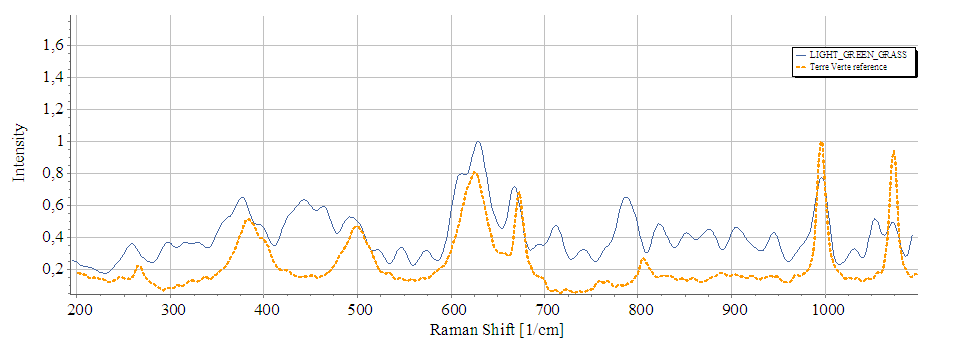 | Figure 7. Raman spectra for green of table 2 (blue line) and reference spectrum of Terre Verte (orange line) |
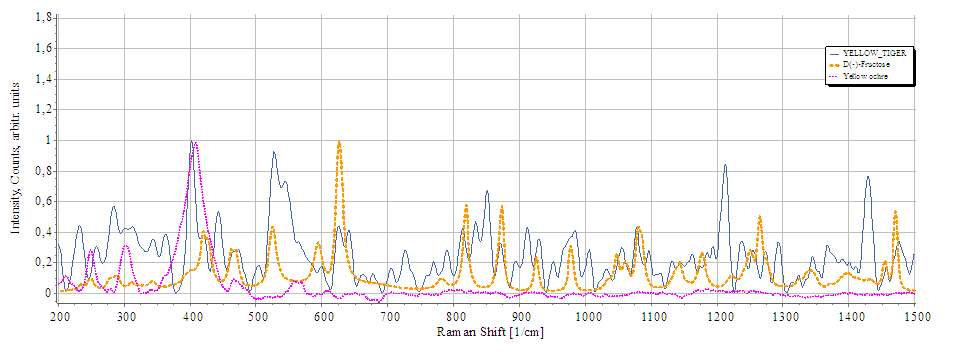 | Figure 8. Raman spectra for yellow of table 2 (blue line) and reference spectrum of fructose (orange dashed line) and yellow ochre (magenta dotted line) |
5. Conclusions
- Summarizing the results of the XRF and Raman analyses, we find that the hypothesis that the painter Theofilos makes the dyes himself from organic raw materials is valid as in addition to white, which is probably Lithopone or Baryte’s white mixed with calcite, the analytical techniques did not reveal inorganic minerals for the pigments.Also, the results of the present study follow the results of previous works regarding a) the white base of paintings containing Calcite (Ca), Barite (Ba) and Zinc (Zn) is therefore a white of Barite with Calcite, b) in its absence copper (Cu) for blue, together with the absence of a substantial amount of Iron (Fe) and cobalt (Co) by exclusion lead to the conclusion of the use of Ultramarine or Indigo, c) for the brown dye where high Iron (Fe) content was found earth pigment has been used.Especially for the blue colorants, this study reveals the use of indigo relevant type of dyes. As these are artworks dated in the last phase of Theophilos' artistic creation, a period that his colour palette and his stylistic choices are strongly influenced by the support he receives from Strati Eleftheriadis (Tériade) it is quite possible to use colorants of better quality than of earlier periods of creation.
 Abstract
Abstract Reference
Reference Full-Text PDF
Full-Text PDF Full-text HTML
Full-text HTML